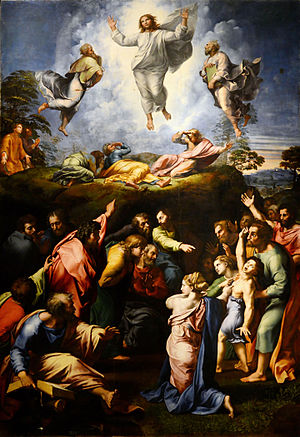Feast of the Transfiguration of the Lord
First Reading: Daniel 7:9-10, 13-14
Responsorial Psalm: Psalm 97:1-2, 5-6, 9
Second Reading: 2nd Letter of St. Peter 1:16-19
Gospel: According to St. Matthew 17:1-9
The papacies of Clement VII and John Paul II, like the men themselves, could not be more different. Clement’s membership in the powerful Florentine de’ Medici family all but assured his election, as he headed the Church from 1523 to 1534 amidst the chaos of a crumbling Christendom. Not only was Clement besieged as the political head of the Papal States, but it was his task to try to hold the Church together in the face of the onrushing Reformation. Luther and Calvin had already made their mark on the Continent, and when Clement denied Henry VII his divorce the British Isles followed suit.
In contrast, St. John Paul came from a humble Polish background and was an unlikely candidate for the papacy on several levels, not least of which was living in a time when it had been over 550 years since a non-Italian had been elected to the Chair of St. Peter. Despite his lack of political DNA, John Paul outshone the child of the de’ Medici dynasty in his dealings with the powers of this world, especially in his role as spiritual architect of the downfall of the Soviet Empire and its hold on the nations of Eastern Europe.
The image of Clement as a prisoner during the sack of Rome in 1527 could not contrast more vividly with that of John Paul visiting the prison cell of his would-be assassin in 1983, yet they are curiously bound together in the event depicted in this weekend’s Gospel story of the Transfiguration.
 Clement, being both a child of the Renaissance and a Medici, was a great patron of the arts who commissioned some of the most outstanding works in the Vatican’s vast collection, including Michelangelo’s Sistine Chapel masterpiece The Last Judgment. One of the most impressive and influential works that Clement commissioned was The Transfiguration by Raphael. Not only did it usher in the Baroque, but it has been described as Raphael’s greatest work, one that uses light and darkness to contrast the divine perfection of Christ with the fallen and sinful world that He came to save.
Clement, being both a child of the Renaissance and a Medici, was a great patron of the arts who commissioned some of the most outstanding works in the Vatican’s vast collection, including Michelangelo’s Sistine Chapel masterpiece The Last Judgment. One of the most impressive and influential works that Clement commissioned was The Transfiguration by Raphael. Not only did it usher in the Baroque, but it has been described as Raphael’s greatest work, one that uses light and darkness to contrast the divine perfection of Christ with the fallen and sinful world that He came to save.
In October 2002 Pope John Paul II issued an Apostolic Letter on the Rosary, Rosarium Virginis Mariae, to mark the beginning of what he called ‘The Year of the Rosary’ in commemoration of Pope Leo XIII’s Encyclical on the rosary published 120 years earlier. John Paul celebrates the beginning of this special year of devotion by proposing an additional group of Mysteries – the Luminous – that can be included among the already established Joyful, Sorrowful and Glorious Mysteries.
These new Mysteries of Light are meant to focus on the public ministry of Jesus, as well as to fill the gap between the last Joyful Mystery – the Finding in the Temple – and the first Sorrowful Mystery – the Agony in the Garden. For John Paul, the greatest of these Mysteries of Light is the Transfiguration:
“The Mystery of Light par excellence is the Transfiguration, traditionally believed to have taken place on Mount Tabor. The glory of the Godhead shines forth from the face of Christ as the Father commands the astonished Apostles to “listen to Him” and to prepare to experience with Him the agony of the Passion, so as to come with Him to the joy of the Resurrection and a life transfigured by the Holy Spirit.”
Raphael brings the image of luminosity into clear focus in The Transfiguration where the contrast between the light at the top of the painting, where Christ is being transfigured, is seen in juxtaposition to the darkness at the bottom, where the Apostles are unable to heal a boy who is tormented by a demon. The Apostles on the bottom-left point to the transfigured Lord above while the child is looking up to Christ, and his wide-open mouth indicates the exit of the demon.
This last work of Raphael may or may not have been his greatest, but it is without a doubt his most defining as an artist. One could even say it was his signature painting since the name Raphael comes from the Hebrew and literally means “God has healed.” The Transfiguration – both as an event and as a painting – is about more than revealing the glorious destiny of Christ in the world, it is about the reason for His entry into the world in the first place – the healing of all those trapped in darkness.
The saintly John Paul knew this explicitly when he visited Ali Ağca in prison, the not-as-saintly Clement knew it implicitly when he commissioned Raphael to create his masterwork, and we – saintly or not – are called to recognize it in all of the events of our lives as Jesus turns darkness into light.
A.M.D.G.